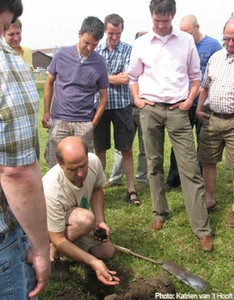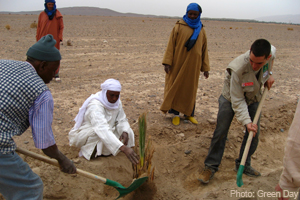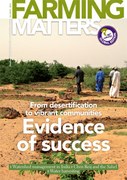Farmers around the world are experimenting with strategies to cope with and restore dry and degraded environments. These may focus on tree planting, or enhancing soil fertility. The following stories are just a few examples of how farmers in different regions use a variety of techniques to enhance ecosystem resilience and protect their livelihoods.
Kenya: Alternative fodder species

In the Kyuso district in Kenya, a number of farmers are adapting by using alternative, drought resistant varieties of animal fodder that are abundant in arid and semi-arid lands, such as acacia pods, tubers from the Thurnbegia guekeana tree, and Melia volkensii fruits and leaves. These crops can provide feed throughout extreme drought periods: some can be harvested in the dry period, when many other water-dependant fodder varieties are unavailable.
Acacia pods can be dried and stored for several months enabling farmers to keep a supply of fodder, and root tubers hold a large amount of water, reducing the drinking water needed by livestock. Nonetheless, switching between fodders can still pose challenges for farmers and animals. Also, there are concerns that tubers that are widely available now may become scarce if more farmers start to make use of them. Planting new tubers and raising awareness on sustainable harvesting might be a solution to this and help communities to become more resilient in the future.
More information?
Contact Anthony Mugo, at ALIN, Kenya, or Donald Inch, at the Scottish Environment Protection Agency.
E-mail: amugo@alin.net or donaldinch@googlemail.com
Argentina: Recovering naturally

The vegetation and soil in these protected areas is able to recover, improving the productivity of the pasture in the long term. The recovery process is being monitored, providing valuable information that can be used in areas with similar problems. After three years, major improvements in plant diversity, ground cover and plant biomass have been observed. The rate of improvement varied in different parts of the area, according to the vegetation type, growth dynamics and weather conditions.
Farmers found that electric fences are the most efficient enclosure technique: they involve less initial expenditure than traditional wire and branch hedges and are easier to manage. These enclosures are playing a significant role in countering desertification, maintaining ecological diversity and productive potential.
More information?
Contact Ana Marina del Carmen Contreras, at Red Agroforestal Chaco Argentina.
E-mail: anitamarinac@gmail.com
The Netherlands: Regaining the lost soil fertility

In 1960 the average Dutch dairy cow would produce 4,200 kg of milk per year, in 2007 this had nearly doubled to about 7,880 kg. But the side effects of this strategy have also become clear, including environmental pollution, dependency on subsidies, and a drastic reduction of soil fertility levels.
Since the 1960s, more than 90% of all Dutch farmers have had to quit farming. Today, a significant part of the remaining dairy farmers are organised in study groups that aim to find ways to improve soil fertility (and incomes!) by improving the interactions within the animal-manure-soilroughage cycle. They have discovered that, by applying less artificial fertilizer and concentrates, and by actively improving soil life, more milk can be produced from the grass and silage produced on their own fields. This has both economic and environmental benefits.
These initiatives are being promoted by several organisations, including the Duurzaam Boer Blijven programme (or “Continue as a sustainable farmer”) that supports groups in the Utrecht and Gelder Valley region and elsewhere. While this process is not widely known beyond Dutch borders, this approach to developing sustainable dairy systems could be taken up elsewhere.
More information?
Contact Katrien van’t Hooft, at Dutch Farm Experience (http://www.dutchfarmexperience.com).
E-mail: katrienvanthooft@gmail.com
Morocco: Intercultural tree planting

For several years, the Moroccan Ministry of Agriculture and the France-Morocco Azzeka Student Association has been working together with different rural communities. Green Day promotes partnership between tourists and visited communities while contributing to the reforestation of palm trees and improving the living conditions of life of disadvantaged rural farmers. On this day of solidarity, palm trees are planted by young students.
The financial resources for this operation are mobilised at European universities, while the Moroccan communities prepare the palm tree seedlings and raise awareness locally about the project and the threat of desertification. On the day itself, the planting of date palm trees is accompanied by cultural activities in the surrounding villages around the theme of desertification.
The higher number of palm trees helps expand the oases where the villagers live, stabilises and feeds the soil and improves climatic conditions. The project also enhances technical and scientific co-operation between France and Morocco and solidarity between individuals and communities in the two countries.
More information?
Contact M. Ali Zahri, at the Ministry of Agriculture (Meknes Tafilalet region).
E-mail: alizahri2004@yahoo.fr

